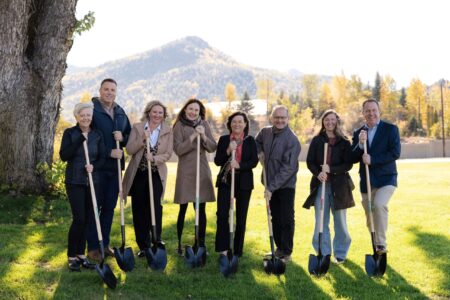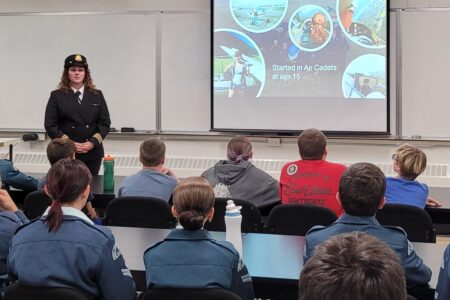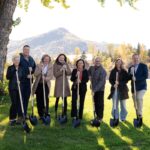Survey finds Rosslanders overwhelmingly support K-12 at RSS and MacLean closure—if they have to choose
Councillors applauded the high level of participation and the quality of data made available by the survey on school options for Rossland recently administered by the Neighbourhood of Learning (NOL) committee.
The survey received input from 520 households on a wide range of issues around the potential for school closures in Rossland. The majority of respondents were households in Rossland (468), but responses were also received from Warfield (16), Trail (9), SD20 (9), and outside School District No. 20 (18).
At Monday evening’s council meeting, Coun. Jill Spearn said that the survey prepared by NOL coordinator Jennifer Ellis was “very professionally done.” Spearn felt the survey “really did prove some things,” for example, Rosslanders feeling “strongly” and “consistently” that “they want K-12 in Rossland.”
There was overwhelming support—more than 75 per cent of households—for the following ranking of four options:
- K-12 at RSS, MacLean closed.
- K-10 at RSS, MacLean closed.
- K-9 at RSS, MacLean closed.
- K-7 at MacLean, RSS closed.
Coun. Kathy Wallace said the report was “very practical, very common sense, with good numbers.” She said to NOL, “all of you are doing a great job for the community.”
Spearn also noted that although the School District No. 20 (SD20) budget recently passed, SD20 separated out school closures and facilities for a yet-to-be-debated motion, probably some time in December.
“Yet again we won’t know the future of what it’s going to look like in Rossland,” Spearn said, but offered her opinion that this gives Rossland “another year to plan, more time for renovations, and more time to prepare kids, families, and businesses.”
Nearly half of the 520 households that responded had two children at the time of the survey. Just under 20 per cent of households had three or more children, the same number had no children, and about 17 per cent had one child.
In total, that represents 859 children in the following age groups: Zero to three (107), four to six (109), seven to nine (128), ten to twelve (111), thirteen to fifteen (87), sixteen to eighteen (74), and nineteen plus (243).
Seventy-four per cent of respondents thought that maintaining grades 8 to 12 in Rossland was “very important,” and an additional 21 per cent thought it was “important.”
The numbers reduce slightly when considering grades 10 to 12: 66 per cent thought it was “very important,” and another 24 per cent thought these grades were “important” to keep in town.
The contribution of RSS to the social and economic viability of Rossland was a consistent theme in responses. For example, 87 per cent of respondents thought that among the greatest concerns surrounding the potential closure of RSS was the potential impact on “the ability of Rossland to attract and keep families.”
The next largest concern—65 per cent of households—was “the loss of community spaces in RSS including the auditorium and gym,” and 59 per cent were worried by “the economic impacts of not having high school students in the community during the day.”
Other concerns felt by half or more of the households include: 1) “Having to send my children out of the community [for high school],” 2) “The loss of the Red Mountain Academy programs,” and 3) “The crowding that would occur if MacLean became K-7.”
Comments also noted the potential loss of community, difficulties with extra curricular activities, and problems associated with bussing children down the hill to Trail, if RSS were to be closed. In general, concern about the closure of RSS was lower for respondents from outside of Rossland.
Although only 24 per cent were “strongly supportive” of RSS becoming a K-12 school, and another 4 per cent were “supportive,” the numbers swell dramatically—to 71 per cent strong support and 19 percent support—with the caveat: “if [K-12 at RSS] is the only option to keep K-12 in the community.” After that caveat, only 10 per cent of households were “mildly” supportive, not supportive, or unsure about RSS becoming a K-12 school.
Concerns with K-12 at RSS ranged from “older children mixing with younger children,” (89 households), to crowding (49), lack of play space (38), insufficient resources for broad course selection (35) and lack of age appropriate facilities (33).
If RSS were closed and MacLean became K-7, 67 households said they would move away from Rossland, and another 157 households said they might move. Some 281 households said the change wouldn’t (or would be unlikely to) precipitate a move.
Of those who would consider a move, 59 households stressed in the comments section that the most important reason was wanting “to live in a community where their child can walk to school.”
The sense of small town community was also important. One respondent wrote, “Kids should go to school in their own community.” Another stressed, “A community raises a child and I feel safe having them in this community.”
One respondent summed it up: “A school is the foundation to any community.” Another called schools “the heart of the community.”
Of some 355 households with children who are high school age or younger, 93 per cent would send their children to RSS if it remains open, with only five per cent planning to send them to J.L. Crowe in Trail.
If RSS were to close, 38 per cent of households would send their kids to Crowe, but 21 per cent would move to another school district, 13 per cent would do homeschool or distance learning, and 26 per cent were still unsure what to do.
The survey also tried out the idea of an independent school to replace RSS, and even the idea that it might be supported by additional municipal taxes.
Both ideas received a considerable amount of support—19 per cent would outright send their kids to an independent school, and 41 per cent would be willing to pay $200 more in taxes to support such a school—but questions of cost were clearly a major factor.
In support of the tax, one respondent wrote, “My property value would decrease by way more than $200 a year if there was no school in Rossland. It’s a small amount to pay for having the facility.”
Another called $200 “a bargain to have a population of teens that are connected to and proud of, their community.”
On the other hand, considering the cost of an independent school, only 144 households would be willing to pay $3000 out of pocket per child per year, while 83 households said they would reach their maximum at $1000. Some 65 households could only attend if it were free, and 177 households were unsure about the maximum they would be willing to spend.
One respondent wrote, “I think [an independent school] would be unfortunate since only the well-to-do would be able to keep their children in town and the others would have to be bused. One of the nice things about this town is that there are very few class differences here: the retired surgeons hang out with the dishwashers. Having a 2 tiered educational system in Rossland like this would begin to create that wedge, and that would undermine the sense of community here.”
The full NOL report can be downloaded below.























